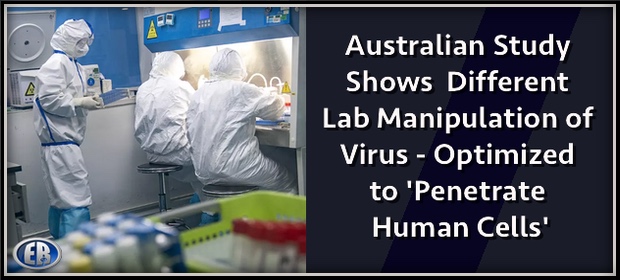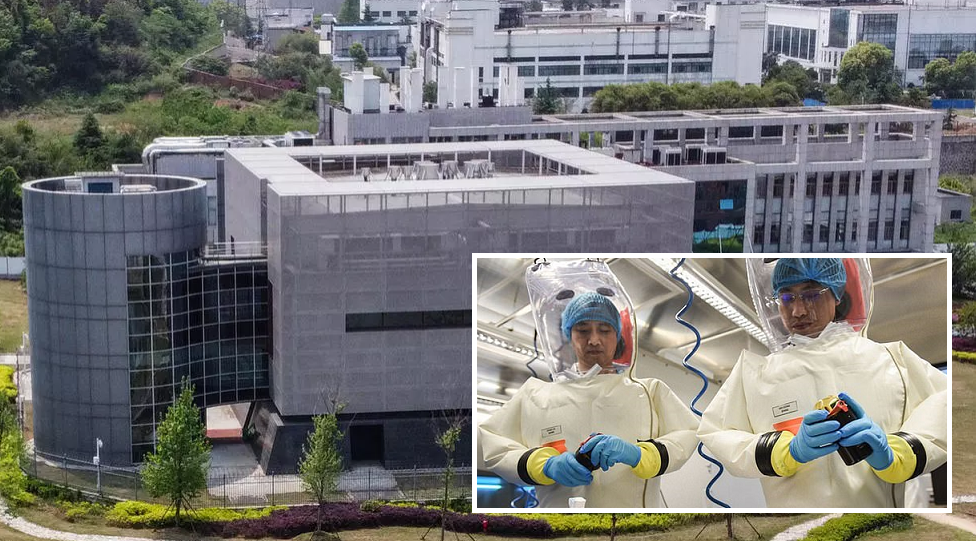
ER Editor: The original, non-peer reviewed study discussed below can be found here: In silico comparison of spike protein-ACE2 binding affinities across species; significance for the possible origin of the SARS-CoV-2 virus.
Where was this virus sample collected? Are the properties found in this virus sample common to strains found in other geographic areas? Are we talking about one thing or many varieties, and is ‘this’, whatever it is, causing people’s apparent illnesses? So many questions remain to be answered.
This analysis appears to contradict others which show that the virus has had other parts spliced into it, such as an HIV component, yet it still shows signs of lab intervention.
********
Study Points To COVID-19 Lab Creation; Lead Author Suggests ‘Forced Selection’ Vs. Genetic Engineering
A study led by Flinders University vaccine researcher Nikolai Petrovsky in Australia reveals that SARS-CoV-2, the virus which causes COVID-19, is optimized for penetration into human cells vs. animal cells – undermining the theory that it naturally evolved in animals before jumping to humans, according to LifeSiteNews‘ Matthew Cullinan Hoffman.
Petrovsky says that the results, which are not peer-reviewed, suggest “a remarkable coincidence or a sign of human intervention.”
The authors of the study, led by vaccine researcher Nikolai Petrovsky of Flinders University in Australia, used a version of the novel coronavirus collected in the earliest days of the outbreak and applied computer models to test its capacity to bind to certain cell receptor enzymes, called “ACE2,” that allow the virus to infect human and animal cells to varying degrees of efficacy.
They tested the propensity of the COVID-19 virus’s spike protein, which it uses to enter cells, to bind to the human type of ACE2 as well as to many different animal versions of ACE2, and found that the novel coronavirus most powerfully binds with human ACE2, and with variously lesser degrees of effectiveness with animal versions of the receptor.
According to the study’s authors, this implies that the virus that causes COVID-19 did not come from an animal intermediary, but became specialized for human cell penetration by living previously in human cells, quite possibly in a laboratory. – LifeSiteNews
Typically, “a virus would be expected to have highest affinity for the receptor in its original host species, e.g. bat, with a lower initial binding affinity for the receptor of any new host, e.g. humans. However, in this case, the affinity of SARS-CoV-2 is higher for humans than for the putative original host species, bats, or for any potential intermediary host species,” wrote the authors.
A “possibility which still cannot be excluded is that SARSCoV-2 was created by a recombination event that occurred inadvertently or consciously in a laboratory handling coronaviruses, with the new virus then accidentally released into the local human population,” they added.
Engineered, naturally…
In a separate statement about the research, Petrovsky suggested that SARS-CoV-2 may not have been ‘spliced’ – which would leave fingerprints of genetic manipulation – but was instead ‘cultured’ to evolve.
“Our and other analyses of the genomic sequence of the virus do not reveal any artificial gene inserts that would be the hallmark of a gene jockey, genetic engineers who manipulate or even create viruses by splicing in artificial inserts into their genome. These are generally easily recognisable and hence clear signatures of human intervention in the creation of a virus. The fact that these artificial inserts are not present has been interpreted by some to mean this virus is not the result of human manipulation.
However, this logic is incorrect as there are other ways in which humans can manipulate viruses and that is caused by natural selection. What do I mean? All viruses and bacteria mutate and adapt to their environment over time, with selection of the fittest individuals for survival in that particular environment.
Take a bat coronavirus that is not infectious to humans, and force its selection by culturing it with cells that express human ACE2 receptor, such cells having been created many years ago to culture SARS coronaviruses and you can force the bat virus to adapt to infect human cells via mutations in its spike protein, which would have the effect of increasing the strength of its binding to human ACE2, and inevitably reducing the strength of its binding to bat ACE2.
Viruses in prolonged culture will also develop other random mutations that do not affect its function. The result of these experiments is a virus that is highly virulent in humans but is sufficiently different that it no longer resembles the original bat virus. Because the mutations are acquired randomly by selection there is no signature of a human gene jockey, but this is clearly a virus still created by human intervention.” – Nikolai Petrovsky
Petrovsky finishes the thought by suggesting that the virus “could have escaped the facility either through accidental infection of a staff member who then visited the fish market several blocks away and there infected others, or by inappropriate disposal of waste from the facility that either infected humans outside the facility directly or via a susceptible vector such as a stray cat that then frequented the market and resulted in transmission there to humans.”
In an email to LifeSite, Petrovsky said that his study suggests that “there are some highly unusual features, including optimal human adaptation, that in the absence of identification of a close to identical virus in an animal population from which COVID19 could have arisen, would point in the direction of human intervention at some point in the evolution of COVID19.”
He also noted that researchers around the world have been unable to produce evidence of the novel coronavirus in animals, which would support their theory of natural development.
“If an animal vector and virus could be found, then of course this would resolve the matter completely,” he told the outlet, adding “One would have thought that the Chinese would be intensively sampling all conceivable animals trying to find such a virus to exonerate their labs. If no such intense search is going on (which I don’t know one way or the other), then the inference could be that they are not looking because they already know what they might find.”
That said, Rutgers molecular biologist Richard Ebright urged caution over the conclusion – teling LifeSite that while Petrovsky’s results “are plausible,” they are “from computational modelling, not from experiments, and therefore must be considered provisional at best.”
Ebright noted that an earlier study on ACE2 receptor binding found that a bat coronavirus similar to the COVID-19 virus had strong binding power with the ACE2 of tree shrews and ferrets, making them possible animal intermediary candidates. However, the study did not compare the binding power of the virus’ animal species’ ACE2 receptors with the binding power with humans, as does Petrovsky’s study. Moreover, it did not use a gene sequence from an early version of the novel coronavirus itself, as does Petrovsky’s study, but rather used the gene sequence of a similar bat coronavirus reported by the Wuhan Institute of Virology, called RaTG13.
Ebright told LifeSite that he believes that multiple physical experiments that will ultimately determine if the novel coronavirus is optimized for binding with human cells are “probably underway in multiple locations,” although he did not cite any specific studies. –LifeSiteNews
According to Petrovsky, an international investigation into the real origins of COVID-19 is required – something the Chinese government has refused to collaborate over.
“Whilst the facts cannot be known at this time, the nature of this event and its proximity to a high-risk biosecurity facility at the epicentre of the outbreak demands a full and independent international enquiry to ascertain whether a virus of this kind of COVID-19 was being cultured in the facility and might have been accidentally released,” wrote Petrovsky.
Original article
************

••••
The Liberty Beacon Project is now expanding at a near exponential rate, and for this we are grateful and excited! But we must also be practical. For 7 years we have not asked for any donations, and have built this project with our own funds as we grew. We are now experiencing ever increasing growing pains due to the large number of websites and projects we represent. So we have just installed donation buttons on our websites and ask that you consider this when you visit them. Nothing is too small. We thank you for all your support and your considerations … (TLB)
••••
Comment Policy: As a privately owned web site, we reserve the right to remove comments that contain spam, advertising, vulgarity, threats of violence, racism, or personal/abusive attacks on other users. This also applies to trolling, the use of more than one alias, or just intentional mischief. Enforcement of this policy is at the discretion of this websites administrators. Repeat offenders may be blocked or permanently banned without prior warning.
••••
Disclaimer: TLB websites contain copyrighted material the use of which has not always been specifically authorized by the copyright owner. We are making such material available to our readers under the provisions of “fair use” in an effort to advance a better understanding of political, health, economic and social issues. The material on this site is distributed without profit to those who have expressed a prior interest in receiving it for research and educational purposes. If you wish to use copyrighted material for purposes other than “fair use” you must request permission from the copyright owner.
••••
Disclaimer: The information and opinions shared are for informational purposes only including, but not limited to, text, graphics, images and other material are not intended as medical advice or instruction. Nothing mentioned is intended to be a substitute for professional medical advice, diagnosis or treatment.





